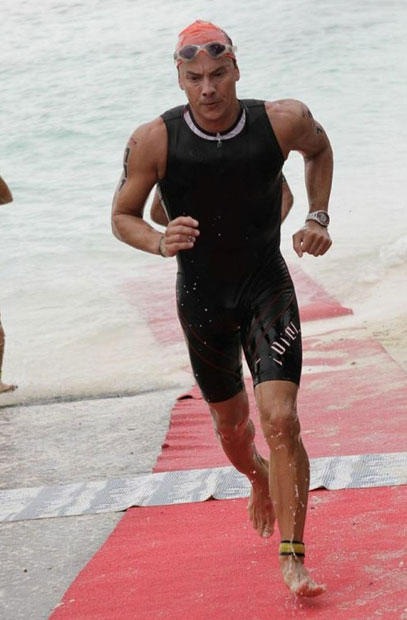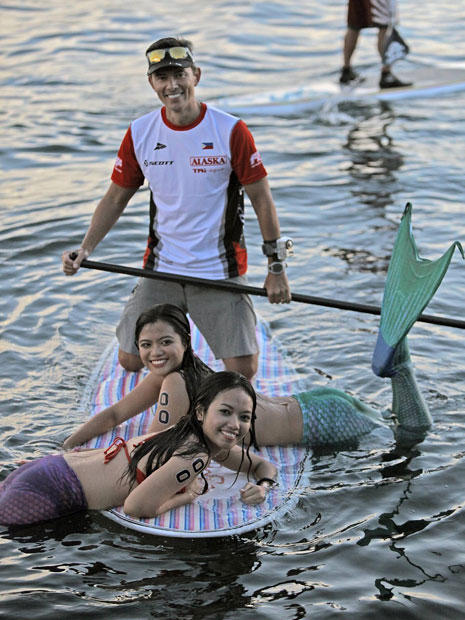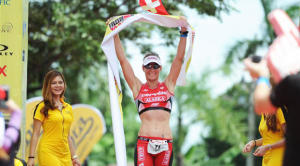Several Pros, including Caroline Steffen and Pete Jacobs, sport the Alaska Milk logo on their race kits, and Alaska Milk Corporation is the largest producer of milk products in the Philippines. Fred Uytengsu is the CEO and president of the company and this former University of Southern Californa swimmer also runs the 70.3 and 5i50 events in the Philippines, manages a Pro basketball team there and is involved in other businesses - and if you happen to be on the campus of USC you may even notice the Uytengsu name on the Aquatic Center, plus like many other age groupers, he also juggles training and family time. Now you can meet this very humble man.
Slowtwitch: Thank you for your time Fred.
Fred Uytengsu: Thanks Herbert. I’m a fan of ST so it’s a pleasure to be interviewed by you.

ST: You are too kind. Another edition of the Cobra Ironman 70.3 Philippines and the Alaska Ironkids is now behind us, does that mean you can breathe easier?
Fred: On the contrary, the day after the 2014 Cobra Ironman 70.3 Philippines, we had an activation with Ironman Foundation to support some of the Typhoon Hainan victims and then we start planning for the Safeguard 5i50 which will be held in September. We also have a very busy schedule in 2015, so I don’t think there is time to kick our heels up. We are only as good as our next race, so we want to continue to improve the athlete experience each and every time.
ST: With your busy job at Alaska Milk, how do actually find time to spend with your family and your passions for basketball and triathlon?
Fred: Like many age group triathletes, it’s all about time management. Early morning workouts (5:30 a.m.), a full day in the office which includes Alaska Milk, the Alaska Aces pro basketball team, Sunrise Events – the franchise holder for Ironman, Ironkids and XTERRA events and some other businesses and evenings are mostly reserved for family unless the Aces are playing. I try and keep my weekends for family except for the long bike ride or run.
This year is a bit of an exception since I’ve been off due to some injuries and minor health issues.
ST: Many triathletes experience that some time after age 40 injuries seem to show up with regular frequency. Has that been case for you?
Fred: Well considering I didn’t return to the sport until my late 30s, I was actually spared from most injuries until my late 40s. These were primarily “over use” injuries such as Morton’s Neuroma - which I had to have removed twice and a bone spur in my left shoulder, presumably from the cumulative effect of years of swimming. I’ve also had a few bouts of kidney stones but can’t discern if that is triathlon related. One school of thought is that dehydration can bring about kidney stones but others suggest this could also be diet and hereditary.
Then I have a nagging calf injury brought about from an imbalance I have in my leg length differential. I broke my tibia when I was a senior in high school and it did not heal properly. So the difference in height can be compensated with orthotics but the biomechanics are less than ideal. Whenever I dial up the running volume too much, then I suffer from a pull or tear in my gastroc.

ST: How did you actually stumble upon triathlon?
Fred: I did my first triathlon shortly after graduating from college. I had retired from competitive swimming but still felt the itch to compete. I never biked or ran competitively so it seemed like an interesting challenge. I completely under estimated the bike and the run (and even the nature of a packed swim with a lot of contact which we don’t have swimming in lanes in a pool). I did a few races in the US and continued when I returned to the Philippines until the late 80s.
Triathlon was truly in fledgling mode back then. I think we had less than 50 people for an Olympic distance race. I stopped training and racing for about 7 years and resumed in the mid 90s. I had picked up a few extra pounds and felt triathlon would be a good way to get back in shape. Again I under estimated what it would take. My first “sprint” was tough but that was the beginning of a journey that has kept me in the sport for the past 18 years as an age grouper and more recently race organizer in addition to racing. Although racing in the races you organize is really brutal.
ST: How often do you race when things fall in place?
Fred: I used to try to get 6 races in a year - a combination of Olympic and 70.3s with the plan or going long (Ironman) every other year. I feel that I must be hungry for an Ironman and simply cannot find the time to train and do the full distance justice. Lately, I’ve dialed it back down to about 4 races a year, of which a couple are 70.3. Between family, work and triathlon this seems to be a good balance for me at the moment.
ST: You swam for USC and were the team captain in 1983 I believe. Do you look fondly back to those times?
Fred: I had the good fortune to “walk on” to USC Men’s Swim Team in 1979. The team was loaded with many All Americans and Olympians. So just being on the team for me was a privilege. Being elected team captain my senior was truly an honor.
I look back at the time I spent swimming at SC as pivotal in my development. Aside from the training and competition, my coach Peter Daland also taught us life lessons and I do believe that helped shape my outlook going in to my professional life. Although you give up a lot to be a college athlete, I think you gain so much more in return. So indeed, I look back on those times very fondly.

ST: What were some of your personal best times then?
Fred: My PB in the 100 meter free was a 54.4; 100 meter fly was a 58.8 and 200 meter fly was a 2:04.5. It’s actually quite surreal that back then you measured your performance in tenths of seconds. In triathlon (even an Olympic race) you are really focused on minutes and hours.
ST: Considering you have the swimming background, the assumption would be that you are fine in the water, but what would you consider your weakest event in a triathlon?
Fred: Correct. My swim has helped. Even after all these years, I manage to get out of the water pretty quickly and in an early pack. My bike is average but my run is really my weakest event. I guess all those years being horizontal in the pool didn’t help but there are many top swimmers who have made the transition to triathlon and put together a good run. I’m still trying to figure that out.
ST: What is your goal in terms of run speed?
Fred: Ha! Wish and goal are two different things but since you ask for goal, I’d have to say I’d be content to run a sub 50:00 off the bike in an Olympic distance race, a 1:50 half marathon and sub 4:30 for Ironman. As you can see, I’m very average on the run, perhaps below average.
ST: Do you even have time to train?
Fred: Most training is early morning workouts. I sometimes can get in a second workout once or twice a week at lunch. And weekends are usually reserved for long bikes and runs. I’ve been with LifeSport for several years now. Lance Watson has coached me and so we focus on the quality of the sessions for the limited time I have to train.

ST: How did you connect with Lance?
Fred: I was at Honu many years back and a friend I swam with in the Philippines invited me to a clinic Lance was giving. I sat in and the next day they had planned this ride from the Mauna Lani in Kona to Koloko and back. If you know this ride, it’s a fair amount of vertical. I wasn’t ready for it and I will say it was damn challenging. After struggling through it, I called Lance and asked if he could help me. The rest is history.
ST: Word has it that you, and of course a big crew, grew that 70.3 Philippines race from a few hundred starters in 2009 to about 2,500 starters this year. Is that more than you expected or is that right about on target in the seemingly triathlon crazy Philippines.
Fred: We have been pleasantly surprised at the response to our first 70.3. Six years ago we had 450 participants. This year we sold out 2,500 (41 countries) slots in four hours and still had 500 on the wait list. The sport is growing but I also think it is about putting on a quality event and not just a race. We look at this holistically and endeavor to make the athlete experience very positive from the moment they land in Manila up through their departure. It’s about having a good, safe course; strong group of Pros that the age groupers can mingle with, putting on a fun carbo/welcome event and designing interesting medals.
But I think what makes our event special is the people. We easily have 10,000 spectators out on race day and we help organize them so they are doing cheers and some school bands are playing. It’s all very festive. It also helps to have a lot of support from local government and our host venue Shangri-la Mactan Resort and Spa.
ST: Next year I think there will be 6 major triathlon events there.
Fred: We just announced our plans to hold two 70.3 races in the Philippines next year in March and August. We also have two 5i50s in June and October. There are six Ironkids events throughout the year. And we are finalizing everything for a 70.3 in Vietnam in the second quarter - so a lot of work ahead. But it’s exciting to see the sport grow as quickly as it has and also the growth of allied businesses such as bike shops and tri apparel to support the sport.
What really excites me is how many people have taken on the active life style of triathlon and many of these people are in their 30s and 40s who may have looked at triathlon as a bucket list item and then embraced the lifestyle.

ST: The impact of the Typhoon in November of 2013 was very tragic, and millions of folks were affected and over 6,000 people died. How much of the destruction is still apparent today?
Fred: I believe a lot of people do not know that Typhoon Hainan was three times the strength of Hurricane Katrina. It was the strongest typhoon every to hit landfall. Close to 20% of the coconut trees were wiped out and it could take up to a decade to restore normalcy. The effects of the damage will last for many years to come and this is why the rehabilitation and reconstruction is so important. It’s no longer on CNN and top of mind awareness but many of the victims are still trying to cope and move forward.
ST: As pesky as some of the news crews can be, once they leave, the attention sadly usually goes away too.
Fred: This is so true and that’s why it is important to start what you finish. We are determined to see these reconstruction efforts be completed and help the people affected go on to lead better lives. We hope to make a difference.
As an example, we had three Filipino triathletes make the lottery for Kona. So their advocacy will build upon the foundation we started and they will try to raise money to build more homes in the village we started. I hope to make this a regular affair.
ST: Where were you doing that time?
Fred: The typhoon struck hardest in the middle of the country. I live in Manila so while there was some strong wind, we didn’t fully understand the magnitude of the destruction. Since all communications were wiped out, it wasn’t until two days after that everyone became aware how devastating this calamity was.
ST: Ironman started a Humanitarian effort, and my wife often wears that t-shirt from that fundraising campaign. Is that something that was noticed locally?
Fred: I’m glad your wife supported the relief effort. If you haven’t picked up a Humanitarian t-shirt, you should too! Immediately after the typhoon I spoke to Andrew Messick (Ironman CEO) and suggested we do something collectively. It was very impressive how quickly the Ironman Foundation responded and the shirts were sold off the Ironman website. We also produced bike jerseys to raise funds in conjunction with Squadra, which manufactures their apparel here in the Philippines and we received items from many professional triathletes to auction off. We raised close to $ 100,000 that enable us to build 25 homes in conjunction with Gawad Kalinga, which is a local version of Habitat for Humanity.
The day after the race this year, we took 15 pros, age groupers together with Geoff Meyer the Ironman Asia Pacific CEO to actually take part in the building and painting of some of these homes on Bantayan Island which is 140 km north of Cebu and was one of the areas badly affected.

ST: Was there ever a doubt if this race should take place this year?
Fred: Cebu city where we hold the race was not really affected by the typhoon. So there was never any doubt about the effects of the typhoon impacting the race. We did have some road issues which are being repaired for the Asia Pacific Economic Council (APEC) meetings next year and that forced us to alter the bike route somewhat. But that is a one off and we expect this to be finalized for next year’s race.
ST: What else can people do to help people there? Are there any other specific foundations you would recommend?
Fred: Rather than spread things out, I would like to see a concerted effort with Gawad Kalinga and help continue building homes and communities. This needs to be a sustainable effort and not just something we do when there is a catastrophe. The Philippines is still a poor country and many people struggle economically event without natural disasters. So if anyone is interested, we are more than willing to have them join our initiatives with GK.
ST: Is there anything else we should know?
Fred: You need to come to the Philippines to see what I’m talking about!
ST: I assume you do not mean just me personally?
Fred: Actually, I do mean you personally! You need to see to believe. So please take this as an invitation for 2015.


